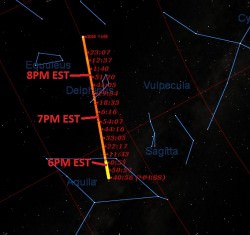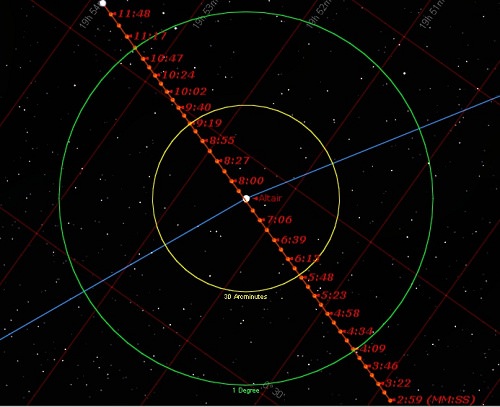[/caption]
It’s already been stated several times here on Universe Today that 2005 YU55, a 400-meter-wide roughly spherical asteroid, will not pose any threat to Earth as it passes by on Tuesday, November 8… even though it will come within 80% of the distance to the Moon. Many experts have come forward to state this fact, including Don Yeomans of JPL’s Near-Earth Object Observation Program and Lance Benner, a radio astronomer with the Deep Space Network in Goldstone, CA. But it will still be a notable event, being the first time since 1976 such a large object will pass so closely by our planet. So, with the eve of YU55’s approach upon us, let’s turn our curiosity toward another aspect of this cosmic visitation: how can we see it?
Unfortunately there are a couple of factors working against the casual observer being able to witness YU55’s pass. One: it’s a dark object. A very dark object. 2005 YU55 is a C-type asteroid, which means it is composed of carbonaceous material and is thus effectively darker than coal, reflecting less than 1% of the sunlight that it receives. It probably won’t be brighter than magnitude 10. (On the backwards-ranked scale of apparent magnitude, 6 is the limit of best visibility to the average human eye, while -1 or 0 would be a very bright star. Jupiter is about -3 right now, while the full moon would be -12.7. In a typical suburban neighborhood 3 or 4 is the limit of naked-eye visibility.)
And two: the Moon will be close to full on the night of the 8th, and YU55 will be headed in its direction. That sure won’t help visibility.
But, should you be located in a dark area, and should you have a 6″ or larger telescope at your disposal, you may want to give a go at spotting the asteroid that’s caused quite a fuss over the past few months for yourself. It won’t be a simple task, but it’s not impossible – and to help you out teacher, writer and astronomy enthusiast David Dickinson has posted an article about it on his blog, Astro Guyz.
Here’s an exerpt:
Closest approach to Earth occurs at 11:29 UTC/06:29 EST at about 202,000 miles distant, placing it high to the southwest for observers on the US Eastern Seaboard. At its closest approach, 2005 YU55 will glide along at one degree every 7 minutes, easily noticeable after a few minutes of observation at low power. I plan to target selected areas with my GOTO mount, sketch the field, then watch for changes. I may also take some wide-field piggyback stills with the DSLR, but mostly, this one will just be fun to watch.
Visually tracking a Near-Earth asteroid can be thrilling to watch; for example, I’ve actually seen 4179 Toutatis years ago show discernable movement after tracking it for a few moments in the eyepiece!
– David Dickinson

The asteroid will pass through the constellations Aquila, Delphinus, and Pegasus as it heads westward. Interestingly, 2005 YU55 passes within a degree of Altair centered on 6:07:30PM EST only 27 minutes after local sunset, and also makes a very close pass of the star Epsilon Delphini during closest approach. These both make good visual “anchors” to aim your scope at during the appointed time and watch. Keep in mind, the charts provided are rough and “Tampa Bay-centric…”
On an approach as close as this one, two factors muddle the precise prediction coordinates of the asteroid; one is the fact the gravitational field of the Earth will change the orbit of 2005 YU55 slightly, and two is that the position will change due to the position of the observer on the Earth and the effect of parallactic shift. Many prediction programs assume the Earthly vantage as a mere point in space, fine for positioning deep sky objects but not so hot for ones passing near the planet. A good place to get updated coordinates is JPL Horizons website which lets you generate an accurate ephemeris for your exact longitude latitude and elevation.
David goes on to add:
2005 YU55 will pass our Moon at 8 AM Universal Time on November 9th at a distance only marginally closer than it did the Earth, at 140,000 miles. Interestingly, it also transited Sun on November 3rd as seen from the Moon, but would have appeared <1” in size, a tough target for any would-be lunar-based observer. Its next close predicted passage of the Earth won’t be until 2056 at nearly 3 times the distance.
__________
Excellent information… many thanks to David for sharing with us! (You can read the full article on his website here.) And if you do witness the pass of this asteroid and somehow manage to get some photos of it, you can share them on the Universe Today Flickr group… they may be featured in an upcoming article!
Read more about 2005 YU55’s close pass by Earth tomorrow.
Charts and excerpts by David Dickinson, created with Starry Night and Paint.

